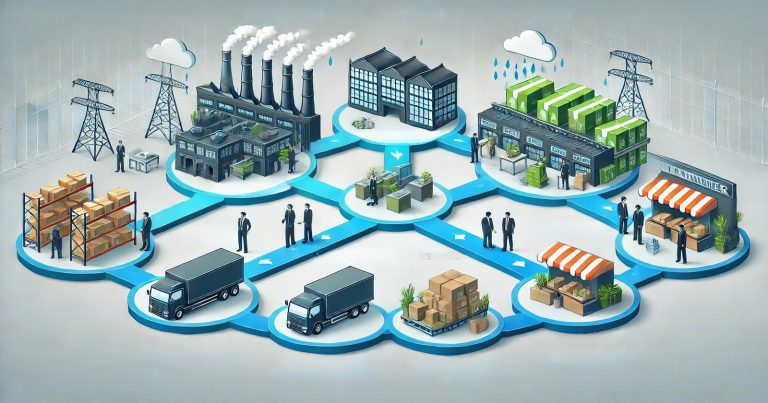Levels of distribution channels reveal the various steps a product undertakes before reaching the customer. It begins at the manufacturer’s level and proceeds to the ultimate buyer. This helps companies make decisions on the best way to sell their products. The three major types include zero-level channels of distribution, one-level channels of distribution, two-level channels of distribution, and three-level channels of distribution. The three levels have distinguishing characteristics and can assist businesses in reaching their targeted customers.
Simplistically put, the distribution channel levels explain the number of wholesalers, retailers, or agents- through which the product passes before reaching the hands of the final consumer. In this case, fewer levels guarantee faster delivery, whereas more levels facilitate wider distribution.
What is a Distribution Channel?
A distribution channel is the process through which a product or service flows from the manufacturer to the final consumer. It is a bridge that enables the exchange of products and services, ensuring they are efficiently delivered as soon as possible.
For instance, when a customer buys a product in a box store or an online order, that product goes through a distribution channel.
Features of Distribution Channel
- It might be composed of producers, wholesalers, retailers, and logistics firms; all could have a hand moving the product from where it is produced to where it ends.
- The distribution channel assumes an important place in business planning. More than mere transport of goods, distribution channels provide value addition in delivering products at the right time, place, and quantity.
- Companies select their channels based on the target audience, the company’s cost structure, and operational abilities to provide the customer with an unbroken experience.
Definition of Distribution Channels
It is the route or chain of intermediaries through which a product or service is passed to reach the consumer. All parties involved in the movement are part of it, such as manufacturers, wholesalers, retailers, agents, and customers. Some firms conduct a direct distribution channel wherein they sell products directly to consumers, while others use an indirect distribution channel involving agents.
One of the crucial goals of a distribution channel is to bridge the production and consumption gap. In such a scenario, when a firm, for example, manufactures mobile handsets, it provides those products to consumers spread over locations through distributors and retailers. Appropriate utilisation of the channels in distribution enhances their coverage, efficiency, and service to the clients.
Levels of Distribution Channels
these are how many intermediaries (like wholesalers, retailers or agents) are involved in getting a product from the maker to the consumer. Fewer levels mean faster delivery, while more can help products reach broader markets.
Zero Level Channel of Distribution or Direct Channel
The zero-level channel of distribution is the most straightforward form. Here, the manufacturer sells its products directly to the consumer, and no intermediate agency is involved in the system. This system is also termed the direct channel. Businesses prefer using this channel to maintain direct contact with their customers. It is easier to understand customer needs better and control the sales process.
Features of Zero-Level Channel of Distribution
Companies save money in the zero-level distribution channel since they do not have to pay intermediaries. They also maintain complete control over how the product is sold—most modern businesses, such as online stores, use this method to reach customers faster. For instance, companies like Apple sell directly to customers at their websites or physical stores.
In this type of channel, businesses can give customised services. They know perfectly who their customers are, what they like, and how they can improve their products. Also, companies can sell at cheaper prices due to eliminating intermediaries.
Examples of Zero Level Channel of Distribution
- Online Shopping: When you purchase something directly from a brand’s website, that is a zero-level channel. For instance, when ordering from Amazon Basics directly on Amazon’s website.
- Company-Owned Stores: Brands like Nike have their stores. When you buy from them, no intermediary is involved.
- Direct Sales: Companies like Amway or Tupperware sell products directly to customers through their representatives.
Advantages of Zero-Level Channel of Distribution
- Cost Savings: No middlemen mean lower costs.
- Faster Delivery: Products reach customers quickly.
- Direct Customer Feedback: Companies learn directly from customers.
- Better Control: Businesses control prices, branding, and customer service.
Disadvantages of Zero-Level Channel of Distribution
- Limited Reach: It’s hard to reach faraway customers without intermediaries.
- High Effort: The company must handle everything—sales, marketing, and logistics.
- More Resources Needed: Businesses need strong online platforms or stores to manage direct sales.
One Level Channel of Distribution
The one-level distribution channel contains only one intermediary between the manufacturer and the customer. This intermediary can be a retailer as well. This system is highly prevalent in industries where manufacturers focus primarily on production while retailers take care of sales.
Features of One-Level Channel of Distribution
The 1-level distribution channel is from the manufacturer to the retailer and eventually the customer. This distribution system allows firms to reach their customers without managing the sales. Retailers deal with selling, stocking, and even promotional activities.
For instance, if a mobile phone firm sells its goods to electronic stores and the customer purchases from that shop, it’s a one-level channel. It’s like making phones for the company while the store concentrates on selling.
Examples of One Level Channel of Distribution
- Electronic Shops: Samsung sells its cell phones to retail companies like Best Buy, which customers buy in stores.
- Supermarkets: Food brands sell their products to supermarkets like Walmart, which sell them to customers.
- Fashion Outlets: Clothing brands sell their products to stores like Zara, and customers purchase them there.
Benefits of One-Level Channel of Distribution
- Broader Coverage: The retailers make the companies cover more customers.
- Less Burden: Companies don’t have to sell directly.
- Retailer’s Know-how: Retailers know the local market well and can efficiently sell their products.
Drawbacks of One-Level Channel of Distribution
- Less Control: Companies don’t have control over retailers’ presentation of their products.
- Profit Sharing: The companies have to share revenues with retailers.
- Dependence: If retailers perform poorly, then there is suffering in the sales of the products.
Two Level Channel of Distribution
It consists of two intermediaries: wholesalers and retailers. The manufacturers sell to wholesalers. They then sell to retailers. Lastly, the retailers sell to customers. This mode is helpful to ensure widely spread products when producing on a large scale.
Features of Two Level Channel of Distribution
Products pass through more hands in a 2-level distribution channel but help reach different regions fast. Wholesale buyers procure large quantities, lowering the manufacturer’s cost. Retailers buy from wholesalers in smaller lots for local sale.
For instance, the biscuit producer sells to a wholesaler wholesale. The wholesaler sells them to small shops, and these stores sell to individuals in the community.
Examples of Two Level Channels of Distribution
- Grocery Products: A corporation such as Nestlé sells it to wholesalers. Wholesalers supply small tuck shops where the customers come to buy it.
- Cosmetics: A company dealing with cosmetics sells to wholesalers. Wholesalers sell the product to shops like pharmacies for the customers.
- Stationery: Pen manufacturers sell to wholesalers, supplying local stationery stores.
Benefits of Two Level Channel of Distribution
- Wider Distribution: Products reach many places fast.
- Lower Costs for Retailers: Retailers buy small quantities at affordable rates.
- Bulk Sales for Manufacturers: Manufacturers sell large amounts simultaneously, saving time and costs.
Drawbacks of Two-Level Channel of Distribution
- Higher Prices: Each intermediary adds their profit, making products more expensive for customers.
- Less Control on the part of the manufacturer as far as display or promotion is concerned.
- Difficulty in obtaining direct feedback from the customers
Three-Level Channel of Distribution
The three-level distribution channel has all three intermediaries: agents, wholesalers, and retailers. A three-level structure is typically used for products reaching international markets or large geographical sectors. Agents ensure the finding of buyers; wholesalers facilitate wholesale distribution while retailers sell to the buyers.
Characteristics of Three-Level Channel of Distribution
Agents play an essential role in the 3 level channel of distribution. Agents do not have ownership of the products but link manufacturers to wholesalers. This system allows manufacturers to specialise in production, and agents, among other intermediaries, manage sales and distribution.
For instance, an international clothing brand contracts agents to locate wholesalers in other countries. The wholesalers distribute to local retailers, and customers buy at the retailers’ shops.
Examples of Three Level Channels of Distribution
- Imported Goods: A Japanese electronics company employs agents to contact wholesalers in the USA. Wholesalers provide products to electronic stores.
- Pharmaceuticals: Drug manufacturers employ agents to handle huge deals with wholesalers who supply pharmacies.
- Automobiles: Car companies employ agents to identify regional distributors, who sell to dealerships, and then cars reach customers.
Benefits of Three-Level Channel of Distribution
- Global Reach: Products can be sold in many countries.
- Expert Support: Agents help with complex deals and negotiations.
- Efficient Distribution: Each intermediary focuses on their expertise—agents find buyers, wholesalers manage stock, and retailers handle sales.
Disadvantages of Three-Level Channel of Distribution
- High Costs: More intermediaries lead to higher costs.
- Complex Management: Managing agents, wholesalers, and retailers takes effort and coordination.
- Slow Feedback: It takes longer for customer feedback to reach the manufacturer.
Comparison of Distribution Channels
Distribution channels provide a clear overview of each channel level’s characteristics, advantages, and disadvantages. Businesses can make informed decisions about their products’ most efficient distribution strategy using such a table.
| Channel Type | Intermediaries Involved | Control Over Sales | Cost | Speed to Market |
| Zero Level Channel | None | Full Control | Low | Fast |
| One Level Channel | Retailer | Moderate Control | Moderate | Fast |
| Two Level Channel | Wholesaler → Retailer | Less Control | Higher | Moderate |
| Three Level Channel | Agent → Wholesaler → Retailer | Least Control | Highest | Slow |
How Does the Distribution Channel Work?
A chain or network should exist for the goods to be distributed appropriately from the producers to consumers, containing certain stages that key players transfer. The process usually begins at the production stage and ends at consumer levels after it reaches consumption. Business models about distribution channels depend upon different product characteristics, target markets, and the scale of the application.
Manufacturers prepare their products for distribution at the production stage. It is realised by ensuring they have qualities and are well packaged. The products are then kept in warehouses waiting for further outlay. The logistics team will transport those products to intermediaries, such as wholesalers or retailers, who play a significant role in overseeing the inventory and ensuring readiness to be used in the market. Sometimes, companies don’t use intermediaries and sell directly to consumers through e-commerce websites or factory outlets.
It involves effective communication as well as high levels of technological usage. Tracking systems, data analytics, and tools in supply chain management enable businesses to track the system to correct the distortions that might arise within the networks. How efficient the distribution channel is will directly tell whether or not the company will be able to meet its expectations to the customer and if it will be profitable.
Examples of Distribution Channel
Distribution channels may take any form, depending on the industry, the type of product, and customer preference. Each example shows the many different ways that firms obtain their customers.
The most basic distribution channel model is direct-to-consumer (DTC) selling, where firms sell directly to customers without any middlemen. For example, a clothing brand might sell through its website or physical stores. In contrast, indirect distribution relies on a mediatory role, such as through wholesalers or retailers. For example, a snack producer may sell and distribute products through supermarkets and convenience shops.
E-commerce sites such as Amazon provide a contemporary illustration of distribution channels that link multi-millions of companies and customers worldwide. For example, service providers, like insurance companies, may depend on brokers or agents to offer their services to customers. Those cases represent the variety and variability of distribution channels, providing an idea of diversification and how companies could adjust their strategy depending on their requirements.
Levels of Distribution Channels FAQs
What are the levels of distribution channels?
The levels of distribution channels refer to the stages a product goes through from the manufacturer to the customer. These include zero, one, two, and three-level channels based on the number of intermediaries involved.
What is the zero-level channel of distribution?
The zero-level distribution channel is where the manufacturer directly sells to the customer without even the involvement of intermediaries, such as through online shopping or company-owned stores.
What is a one-level channel of distribution?
A one-level distribution channel would be that there is one single intermediary, typically a retailer, between the manufacturer and the customer.
What is a level channel of distribution?
A level distribution channel is a distribution system with two intermediaries that separate the manufacturer from the final customer; the intermediaries include wholesalers and retailers.
Three-level channel of distribution: Do you have some examples?
Yes, the level distribution channel is products with agents, wholesalers, and retailers. Some of them are imported electronics, pharmaceuticals, and cars.


